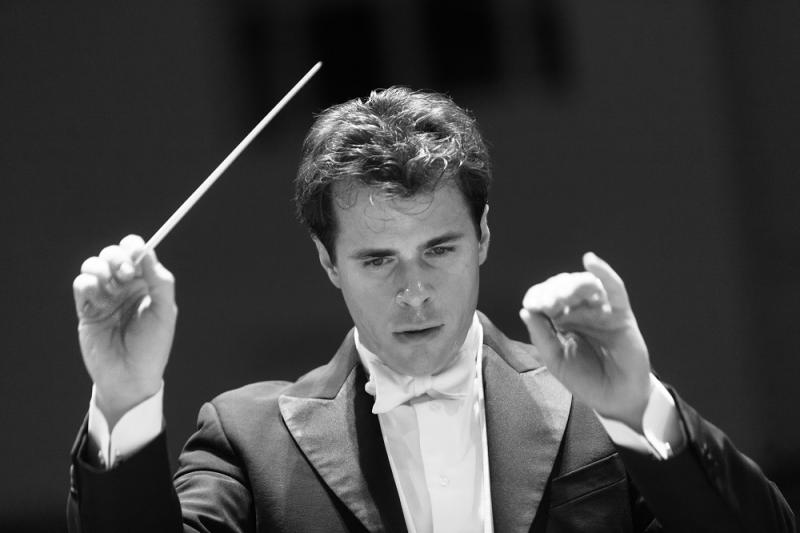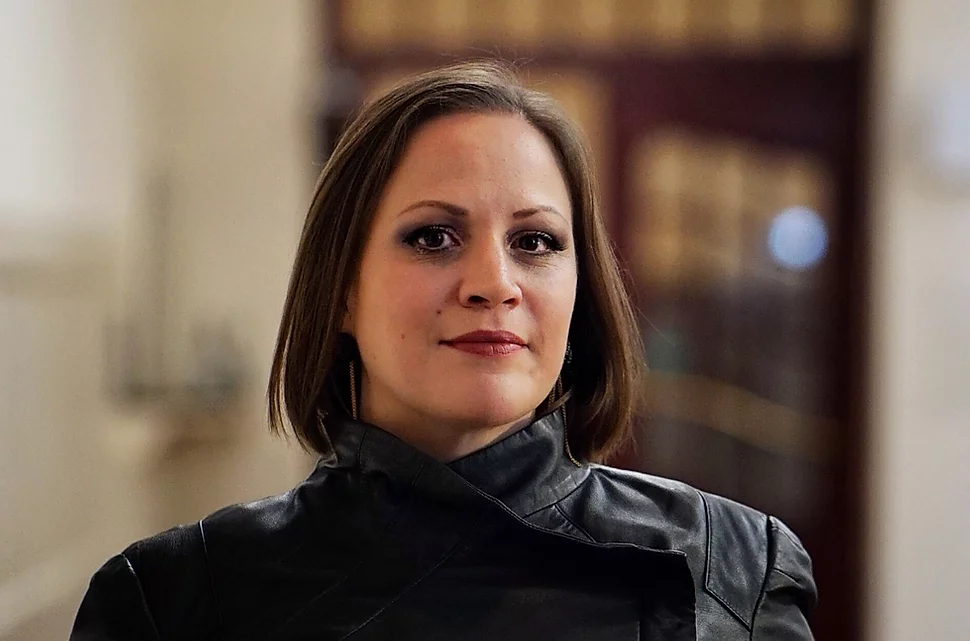Mahler's 'Resurrection' Symphony, Philharmonia, Hrůša, RFH review - big picture, stunning details | reviews, news & interviews
Mahler's 'Resurrection' Symphony, Philharmonia, Hrůša, RFH review - big picture, stunning details
Mahler's 'Resurrection' Symphony, Philharmonia, Hrůša, RFH review - big picture, stunning details
Transcendent idylls matter as much as great blazes in this broad view

So many performances of Mahler's most theatrical symphony every season, so few conductors who have something radically fresh to say about it.
The breadth of Hrůša's interpretation – the polar opposite of the last "Resurrection" I heard, Gianandrea Noseda's lightning whizz with the brand-new Pan-Caucasian Youth Orchestra in Georgia – altered perspectives. Usually the first extended vision of heaven we get is in the fourth-movement song based on a folk poem, "Urlicht" ("Primeval Light"), as good as any I've heard here – Jennifer Johnston (pictured below by R T Dunphy) producing the authentic frisson with her pitch-altering first entry after the pell-mell human comedy of the Scherzo, fuller voiced than usual in the upper register, the true contralto. Equally levitational here, however, were the vision that offsets the "funeral rites" at the heart of the first movement, flecked with expressive colour from superlative young oboist Tom Blomfield (a star in the Philharmonia's recent performance of Strauss's Oboe Concerto), cor anglas player Maxwell Spiers and first horn Nigel Black, haloed by softest strings, and the whole of what usually comes over as the "old-fashioned" minuet sequel.
Here hyper-sensitive strings made us hold our breath through each Schubertian round-dance and Hrůša extracted the heavenly humour from the heavenly music-box sequence of pizzicati, piping piccolo and very present harps.It's also worth remembering that like his great mentor, Jiří Bělohlávek, Hrůša hails from the same part of the world as Mahler – not for nothing did Bělohlávek claim the composer as a true Czech – so the moments of rustic wonder do somehow leap out.
Every orchestral principal rose to difficult challenges with compelling individuality, supremely so first trumpeter Christian Barraclough (his offstage counterpart, Jason Evans, touched the metaphysical, too, with two notes at the last trump, magically echoed as ever by the flute family playing at nightingales). Collective punches were never pulled, right from the electrifying opening, and the doomy marching didn't outstay its welcome, even if the Last Judgment hordes were still the aural equivalent of D W Griffiths meeting Keystone Cops.
Then the pianissimo choral entry with the Resurrection Ode - has it ever sounded more mystical? At the other end of the dynamic scale, the men had all the heft of a Welsh male-voice choir. At last the City of Birmingham Symphony Chorus have a rival in a work they've owned, up to now. Soprano Camilla Tilling wasn't in best voice for the rising from the masses, the one less than perfectly articulated sequence; but in the bigger picture and the great final blaze, seismically rocked by the double-basses, that was soon forgotten. And what a joy, at last, to see orchestral musicians showing visible pleasure in their colleagues' work.
rating
Share this article
Add comment
The future of Arts Journalism
You can stop theartsdesk.com closing!
We urgently need financing to survive. Our fundraising drive has thus far raised £49,000 but we need to reach £100,000 or we will be forced to close. Please contribute here: https://gofund.me/c3f6033d
And if you can forward this information to anyone who might assist, we’d be grateful.

Subscribe to theartsdesk.com
Thank you for continuing to read our work on theartsdesk.com. For unlimited access to every article in its entirety, including our archive of more than 15,000 pieces, we're asking for £5 per month or £40 per year. We feel it's a very good deal, and hope you do too.
To take a subscription now simply click here.
And if you're looking for that extra gift for a friend or family member, why not treat them to a theartsdesk.com gift subscription?
more Classical music
 Jansen, LSO, Pappano, Barbican review - profound and bracing emotional workouts
Great soloist, conductor and orchestra take Britten and Shostakovich to the edge
Jansen, LSO, Pappano, Barbican review - profound and bracing emotional workouts
Great soloist, conductor and orchestra take Britten and Shostakovich to the edge
 Jakub Hrůša and Friends in Concert, Royal Opera review - fleshcreep in two uneven halves
Bartók kept short, and a sprawling Dvořák choral ballad done as well as it could be
Jakub Hrůša and Friends in Concert, Royal Opera review - fleshcreep in two uneven halves
Bartók kept short, and a sprawling Dvořák choral ballad done as well as it could be
 Hadelich, BBC Philharmonic, Storgårds, Bridgewater Hall, Manchester review - youth, fate and pain
Prokofiev in the hands of a fine violinist has surely never sounded better
Hadelich, BBC Philharmonic, Storgårds, Bridgewater Hall, Manchester review - youth, fate and pain
Prokofiev in the hands of a fine violinist has surely never sounded better
 Monteverdi Choir, ORR, Heras-Casado, St Martin-in-the-Fields review - flames of joy and sorrow
First-rate soloists, choir and orchestra unite in a blazing Mozart Requiem
Monteverdi Choir, ORR, Heras-Casado, St Martin-in-the-Fields review - flames of joy and sorrow
First-rate soloists, choir and orchestra unite in a blazing Mozart Requiem
 Cho, LSO, Pappano, Barbican review - finely-focused stormy weather
Chameleonic Seong-Jin Cho is a match for the fine-tuning of the LSO’s Chief Conductor
Cho, LSO, Pappano, Barbican review - finely-focused stormy weather
Chameleonic Seong-Jin Cho is a match for the fine-tuning of the LSO’s Chief Conductor
 Classical CDs: Shrouds, silhouettes and superstition
Cello concertos, choral collections and a stunning tribute to a contemporary giant
Classical CDs: Shrouds, silhouettes and superstition
Cello concertos, choral collections and a stunning tribute to a contemporary giant
 Appl, Levickis, Wigmore Hall review - fun to the fore in cabaret and show songs
A relaxed evening of light-hearted fare, with the accordion offering unusual colours
Appl, Levickis, Wigmore Hall review - fun to the fore in cabaret and show songs
A relaxed evening of light-hearted fare, with the accordion offering unusual colours
 Lammermuir Festival 2025, Part 2 review - from the soaringly sublime to the zoologically ridiculous
Bigger than ever, and the quality remains astonishingly high
Lammermuir Festival 2025, Part 2 review - from the soaringly sublime to the zoologically ridiculous
Bigger than ever, and the quality remains astonishingly high
 BBC Proms: Ehnes, Sinfonia of London, Wilson review - aspects of love
Sensuous Ravel, and bittersweet Bernstein, on an amorous evening
BBC Proms: Ehnes, Sinfonia of London, Wilson review - aspects of love
Sensuous Ravel, and bittersweet Bernstein, on an amorous evening
 Presteigne Festival 2025 review - new music is centre stage in the Welsh Marches
Music by 30 living composers, with Eleanor Alberga topping the bill
Presteigne Festival 2025 review - new music is centre stage in the Welsh Marches
Music by 30 living composers, with Eleanor Alberga topping the bill
 Lammermuir Festival 2025 review - music with soul from the heart of East Lothian
Baroque splendour, and chamber-ensemble drama, amid history-haunted lands
Lammermuir Festival 2025 review - music with soul from the heart of East Lothian
Baroque splendour, and chamber-ensemble drama, amid history-haunted lands
 BBC Proms: Steinbacher, RPO, Petrenko / Sternath, BBCSO, Oramo review - double-bill mixed bag
Young pianist shines in Grieg but Bliss’s portentous cantata disappoints
BBC Proms: Steinbacher, RPO, Petrenko / Sternath, BBCSO, Oramo review - double-bill mixed bag
Young pianist shines in Grieg but Bliss’s portentous cantata disappoints

Comments
Which concert were you at?
I sense there's not going to
I sense there's not going to be much finding of a middle way here, but let me assure you that neither in person nor as a conductor is Hrůša a flash merchant (though Mahler, in this symphony, often is). Try his Brahms; ask players what they think, and the response of the ones I know will be the opposite to you. Your last sentence clearly lacks any humility, but it's your opinion.And you didn't read either the review or your programme properly: I compared the Philharmonia Chorus to the CBSO Chorus, but it was, naturally, the former performing, not the latter.
I was at the same concert as